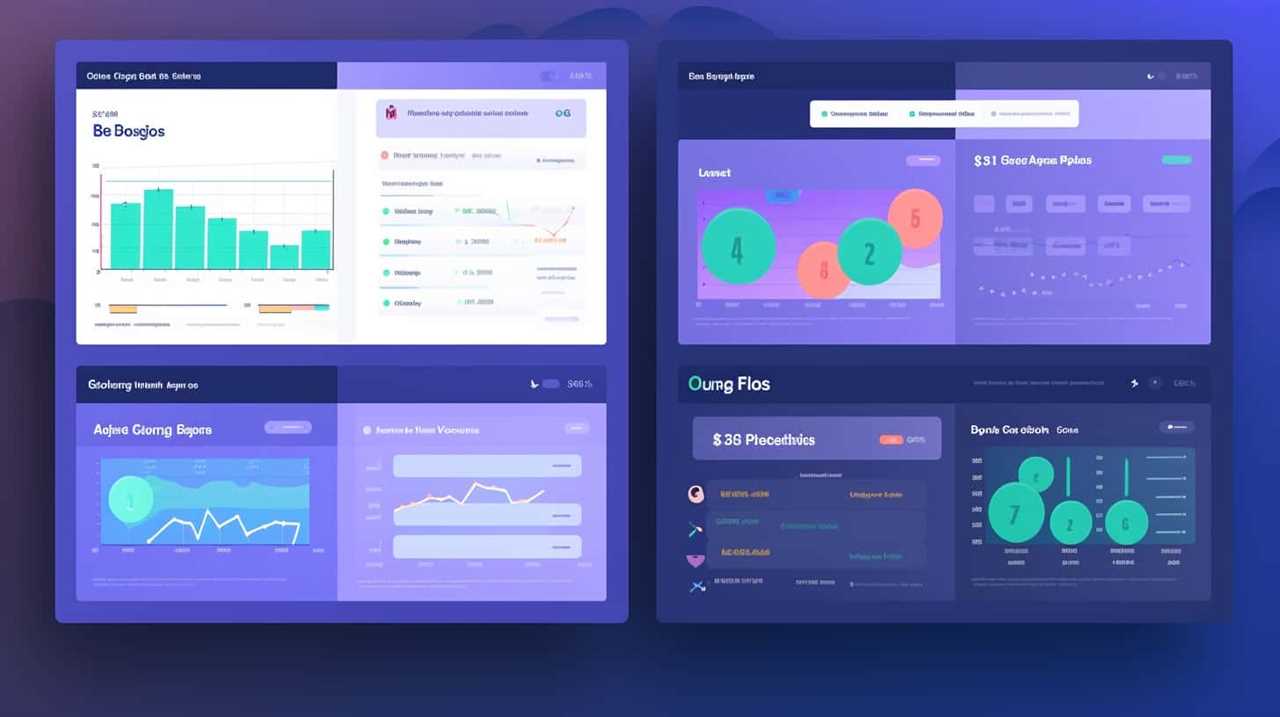Fed up with producing SEO content that falls short of your expectations? We understand your annoyance. This is why we have compiled a list of 10 tactics aimed at aiding you in attaining both regularity and triumph in your endeavors to create successful SEO content.
Through extensive research and analysis, we’ve discovered the most effective techniques for optimizing your website and driving organic traffic. Whether you’re a seasoned marketer or just starting out, these strategies will empower you to master the art of SEO content creation.
Key Takeaways
- Conduct thorough keyword research to identify relevant and high-volume keywords for SEO optimization
- Create high-quality and engaging content that incorporates keywords naturally and provides value to readers
- Optimize website for mobile devices to ensure a positive user experience and avoid high bounce rates
- Implement effective link building strategies and leverage social media platforms to increase visibility and reach a wider audience
Keyword Research: Uncovering the Most Relevant Terms
In our quest for effective SEO content, we embark on the crucial task of uncovering the most relevant terms through keyword research.
One key aspect of this process is conducting a competitive analysis. By analyzing the keywords that your competitors are targeting, you can gain valuable insights into what terms are driving traffic to their websites. This information can help you identify gaps and opportunities in your own keyword strategy.

Another important element of keyword research is identifying long tail keywords. These are longer, more specific phrases that are often less competitive but have higher conversion rates. Long tail keywords allow you to target a niche audience and attract visitors who are more likely to convert into customers.
On-Page Optimization: Optimizing HTML Elements for SEO
To optimize HTML elements for SEO, we focus on utilizing subordinating conjunctions and adopting a first person plural point of view, active voice, and contractions. Optimizing meta tags and implementing structured data are key strategies for improving on-page optimization. Meta tags provide information about a webpage, helping search engines understand its content. By optimizing meta tags with relevant keywords, we can increase the chances of our webpage appearing in search results. Structured data implementation involves adding specific markup to HTML elements, allowing search engines to better understand the context of the content. This can lead to improved visibility and higher rankings in search engine results. In order to achieve effective on-page optimization, it is essential to pay attention to these HTML elements and ensure they are optimized for SEO.
| HTML Element | Purpose | Optimization Tips |
|---|---|---|
| Title Tag | Describes the webpage | Include target keyword near the beginning |
| Meta Description | Provides summary of content | Use relevant keywords and compelling language |
| Header Tags | Organize content hierarchy | Incorporate keywords and maintain logical structure |
| Image Alt Text | Describes image content | Include descriptive keywords for accessibility |
High-Quality Content: Creating Valuable and Engaging Material
We continue our exploration of optimizing HTML elements for SEO by shifting our focus to high-quality content creation, ensuring valuable and engaging material.
- When creating shareable content, it’s essential to understand your target audience and their interests. Conduct thorough research to identify trending topics and relevant keywords that resonate with your audience.
- Craft compelling headlines and introductions to capture readers’ attention and entice them to continue reading. Use storytelling techniques and powerful language to make your content memorable.
- Incorporate visual elements such as images, infographics, and videos to enhance the overall experience. Visual content can help convey complex concepts and make your content more shareable.
Measuring content effectiveness is crucial to ensure that your efforts are paying off. Use analytics tools to track metrics such as pageviews, time on page, bounce rate, and social shares. Analyzing these metrics will help you identify what content resonates most with your audience and make data-driven decisions to optimize future content.

Transition: Now that we’ve discussed creating valuable and engaging content, let’s explore how user experience plays a vital role in enhancing navigation and readability.
User Experience: Enhancing Navigation and Readability
When it comes to user experience, simplifying website navigation is crucial. By organizing the content in a logical and intuitive manner, users can easily find what they’re looking for without getting lost or frustrated.
Additionally, clear and concise content enhances readability, making it easier for users to understand and absorb the information presented.
Simplifying Website Navigation
Enhancing navigation and readability on websites can be achieved by simplifying website navigation. By simplifying the website structure and optimizing navigation menus, users can easily find the information they’re looking for, resulting in a better user experience.

Here are three strategies to simplify website navigation:
- Streamline menu options: Reduce the number of menu items to the essential categories, making it easier for users to navigate through the website.
- Use descriptive labels: Ensure that the labels used in the navigation menus accurately represent the content within each section, providing clear guidance to users.
- Implement a search bar: Including a search bar on the website allows users to quickly find specific information without having to navigate through multiple pages.
Clear and Concise Content
To further improve user experience and readability, we can focus on creating clear and concise content that enhances website navigation. By utilizing concise writing techniques and avoiding jargon, we can ensure that our content is easily understood and accessible to our audience.
Concise writing involves using precise and succinct language to convey our message effectively. This means eliminating unnecessary words and phrases that can confuse or overwhelm readers. By doing so, we can enhance the readability of our content and make it easier for users to navigate through our website.
Clear and concise content not only improves user experience but also helps to establish credibility and authority in our field. Therefore, it’s essential to prioritize clarity, conciseness, and precision in our writing to create impactful and user-friendly content.

Mobile Optimization: Ensuring Compatibility With Mobile Devices
When it comes to mobile optimization, website speed plays a crucial role in ensuring a positive user experience. Slow-loading websites can lead to frustration and high bounce rates, negatively impacting your SEO efforts.
Implementing responsive design best practices is also essential to ensure compatibility with different mobile devices, allowing your content to adapt seamlessly across screens of various sizes.
Website Speed Importance
Ensuring compatibility with mobile devices is crucial for optimizing website speed. As more and more people use smartphones and tablets to access the internet, it’s essential that websites are designed to load quickly and efficiently on these devices.
Improving loading speed is a top priority for website owners, as slow-loading sites can lead to high bounce rates and decreased user satisfaction. One way to improve loading speed is by optimizing images. By reducing the file size of images and using modern image formats, such as WebP, websites can load faster without sacrificing image quality.

Additionally, it’s important to minimize the use of plugins and scripts that may slow down the website. By following these strategies, website owners can ensure that their site is compatible with mobile devices and provides a seamless user experience.
Responsive Design Best Practices
Responsive design is a key aspect of optimizing websites for mobile devices. As more and more people access the internet through their smartphones and tablets, it’s crucial for websites to provide a seamless user experience across all devices.
To ensure compatibility with mobile devices, here are some responsive design tips that can help improve the mobile user experience.
Firstly, it’s important to prioritize content and functionality. Mobile users have limited screen space, so it’s essential to focus on the most important elements. Simplify navigation and eliminate unnecessary features to make the website more user-friendly.

Secondly, optimize images and videos for mobile devices. Large files can slow down the loading speed, which can frustrate users. Compress images and use HTML5 video players to improve performance.
Lastly, test the website on different devices and screen sizes to ensure it looks and functions properly. Regularly monitor and update the website to keep up with the ever-changing mobile landscape.
Link Building: Establishing Authority and Relevance
In the article, we explore the importance of link building in establishing authority and relevance in SEO content.
Link building is a crucial strategy in optimizing a website’s search engine ranking and attracting organic traffic.

Here are three key reasons why establishing backlinks is essential for building authority and relevance:
- Improved search engine visibility: Backlinks from reputable and relevant websites signal to search engines that your content is trustworthy and valuable, leading to higher rankings in search results.
- Increased website traffic: When authoritative websites link back to your content, it drives referral traffic to your site, increasing your chances of converting visitors into customers.
- Enhanced industry authority: By earning backlinks from influential websites in your industry, you establish yourself as a thought leader, gaining credibility and recognition within your niche.
Social Media Integration: Leveraging Social Platforms for SEO
When it comes to SEO, social media integration is a crucial aspect that can’t be overlooked. Social signals, such as likes, shares, and comments, can have a significant impact on search engine rankings.
By promoting content across various social platforms, businesses can increase their visibility and reach a wider audience. Additionally, collaborating with influencers in the industry can further enhance SEO efforts by leveraging their followers and credibility.
Social Signals and SEO
To optimize SEO results, we actively integrate social media platforms for leveraging social signals. Social signals and user engagement play a crucial role in determining the relevance and credibility of a website. By incorporating social media promotion and brand visibility strategies into our SEO content, we can effectively increase our online presence and drive more traffic to our website.

Here are three key ways in which social signals and SEO intersect:
- Sharing and engagement on social media platforms can boost the visibility of our content and attract more visitors to our website.
- Social media profiles and interactions can contribute to our brand’s online reputation and authority, which in turn enhances our SEO rankings.
- Social media platforms provide an avenue for building relationships and connecting with our target audience, allowing us to better understand their needs and preferences.
In the next section, we’ll explore the importance of cross-platform content promotion and how it can further enhance our SEO efforts.
Cross-Platform Content Promotion
We actively incorporate social media integration to leverage social platforms for SEO through cross-platform content promotion.
Cross-platform content promotion involves distributing our content across different social media channels to reach a wider audience and improve our search engine rankings.

By utilizing social media platforms such as Facebook, Twitter, Instagram, and LinkedIn, we can increase the visibility and reach of our content. This strategy allows us to engage with our target audience on various platforms, promoting our content and driving traffic back to our website.
Additionally, cross-channel promotion ensures that our content is seen by different user demographics, expanding our reach and increasing the likelihood of gaining new followers, subscribers, and potential customers.
Influencer Collaborations for SEO
Continuing the discussion from the previous subtopic, our team actively incorporates influencer collaborations to leverage social platforms for SEO.
Influencer marketing has become an integral part of our content strategy, allowing us to reach a wider audience and increase brand visibility.

Here’s how we approach influencer collaborations:
- Identifying the right influencers: We conduct thorough research to find influencers who align with our brand values and target audience. This ensures that our collaborations are authentic and resonate with our audience.
- Collaborating on content creation: We work closely with influencers to create high-quality content that not only showcases our products or services but also provides value to their followers. This helps us build credibility and gain trust from our target audience.
- Amplifying content through social platforms: Once the content is created, we leverage social platforms to promote it. By partnering with influencers who have a strong social media presence, we can amplify our reach and drive more traffic to our website.
Incorporating influencer collaborations into our SEO strategy has proven to be highly effective in increasing brand visibility and driving organic traffic.
However, to ensure continuous improvement, it’s crucial to analyze data, monitor performance, and make data-driven decisions.
Analyzing Data: Monitoring Performance and Making Data-Driven Decisions
As we delve into the subtopic of monitoring performance and making data-driven decisions in the realm of SEO content, we embark on the journey of analyzing data to unlock its valuable insights.

Monitoring competitors and optimizing meta tags are crucial aspects of this process. By closely monitoring our competitors, we can gain insights into their strategies, identify gaps, and discover opportunities to improve our own SEO content. Additionally, optimizing meta tags with relevant keywords and compelling descriptions can significantly impact search engine rankings and click-through rates.
Analyzing data allows us to measure the effectiveness of our SEO efforts, identify areas for improvement, and make data-driven decisions to enhance our content strategy. By leveraging the power of data, we can continuously refine our SEO content and drive consistent and impactful results.
Now, let’s transition into the subsequent section about SEO auditing: assessing and improving website performance.
SEO Auditing: Assessing and Improving Website Performance
To effectively assess and improve website performance, it’s essential to delve into the process of SEO auditing. Conducting an SEO audit allows you to identify areas of improvement and make data-driven decisions to optimize your website’s SEO efficiency.

Here are three key steps to consider when assessing website performance:
- Technical analysis: Evaluate the technical aspects of your website, such as site speed, mobile-friendliness, and crawlability. Address any issues that may hinder search engine visibility and user experience.
- On-page optimization: Review your website’s content, meta tags, and keyword usage. Ensure that your pages are properly optimized with relevant keywords and engaging content that resonates with your target audience.
- Backlink analysis: Analyze your website’s backlinks to assess their quality and relevance. Remove any toxic or low-quality links and focus on acquiring high-quality backlinks from reputable sources.
Staying Up to Date: Keeping Abreast of Algorithm Changes and Industry Trends
We stay updated on algorithm changes and industry trends to ensure our SEO content remains effective and impactful.
Staying informed about algorithm updates is crucial in order to adapt our strategies and maintain high rankings on search engine result pages. Algorithm changes, such as Google’s updates to its core algorithm, can have a significant impact on website visibility and organic traffic. By keeping abreast of these changes, we can make necessary adjustments to our content and optimization techniques.
Additionally, staying informed about industry trends allows us to anticipate shifts in user behavior and preferences, ensuring that our content remains relevant and engaging. We regularly monitor industry publications, attend conferences, and participate in online forums to gather insights and stay ahead of the curve.

Frequently Asked Questions
How Can I Determine the Most Relevant Keywords for My Website?
When determining the most relevant keywords for our website, we engage in thorough keyword research and employ SEO optimization techniques. This ensures that our content is targeted, optimized, and impactful for our audience’s mastery in SEO.
What Are the Key HTML Elements That Should Be Optimized for Better Seo?
Optimizing HTML elements is crucial for better SEO. By following best practices, we can maximize our SEO potential. Understanding the key elements and optimizing them strategically will lead to improved search engine rankings and increased visibility for our website.
How Can I Create Content That Is Both Valuable and Engaging for My Audience?
To create content that resonates with your target audience and drives conversions, we need to focus on delivering value and engaging storytelling. Additionally, we should measure the success of our content marketing efforts effectively.
What Strategies Can I Implement to Improve the Navigation and Readability of My Website?
To improve navigation and readability, we can implement effective website structure for easy navigation and utilize visual elements for improved readability. These strategies will enhance the user experience and make our content more accessible and engaging.

How Can I Ensure That My Website Is Optimized for Mobile Devices?
To ensure our website is optimized for mobile devices, we prioritize a mobile-friendly design and implement responsive web design techniques. This guarantees a seamless user experience across different screen sizes and improves overall accessibility.
Conclusion
In conclusion, mastering the art of SEO content requires a combination of research, strategy, and adaptability. By conducting thorough keyword research, optimizing on-page elements, and creating high-quality, user-friendly content, businesses can enhance their online presence and attract more organic traffic.
Additionally, staying up to date with industry trends and algorithm changes is crucial for maintaining consistent impact. As the saying goes, ‘The only constant in life is change,’ and this rings true in the ever-evolving world of SEO.










